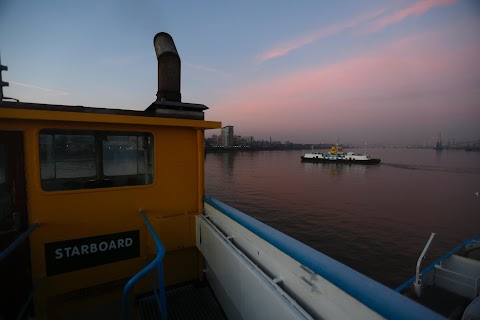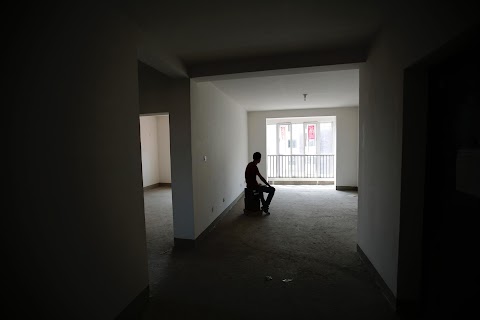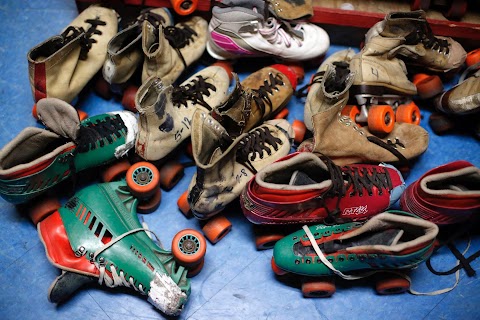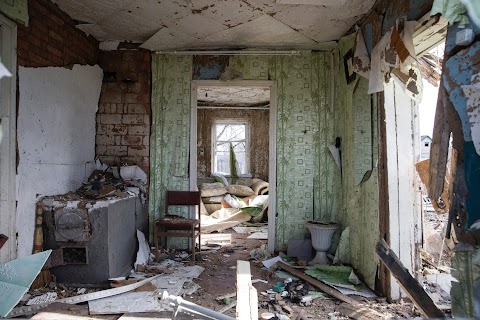
London's ancient ferry
 Russell Boyce
Russell Boyce
One of London’s most striking features, the Thames runs through the British capital and has throughout the centuries played a pivotal role in the life of the city. It is no surprise that Londoners from ancient Romans to modern day drivers have paid great attention to where and how to cross it.
Woolwich, in south east London, has been the site of a river crossing since Saxon times. It is now home to a free ferry service transporting passengers and vehicles over the great river.

A deckhand directs vehicles onto the James Newman ferry. It is one of the three Woolwich ferries built in 1963 and named after local politicians; the others are John Burns and Ernest Bevin.
Before the free ferry service opened in 1889, the crossing had changed hands several times. In 1308, a mason called William Atte bought the ferry business for 10 pounds. Twelve years later the business was sold for 100 silver marks. During the reign of Henry VIII, the military established its own ferry in Woolwich.

The Woolwich ferry viewing tower controls the ramps to the boats and is known to the staff as the the “bubble”.
Tony Kane is one of the 21 traffic controllers helping to operate the service seven days a week. The ferry also employes two store-men, three shipwrights, two plumbers, five fitters, two boiler makers, three electricians, two painters, four semi skilled engineering workers, two managers and five boat crews of nine, all administrated by a staff of eight.

Latest statistics show that some 80,000 vehicles and 22,000 foot passengers use the free ferry service each month.
But for pedestrians, the ferry is not the only way to cross the Thames in Woolwich. A 504-metre long tunnel was built under the river in 1912 to ensure that residents, dock and shipyard workers could traverse it in all weather conditions.
Video
A time-lapse shows the captain Dave Watkins navigating the James Newman ferry across the River Thames.
"There has been a river crossing at Woolwich since the Saxon times."
Anyone who drives in London knows the struggle of crossing the River Thames, especially in the east of the capital. Sixteen miles to the west from the arterial Blackwall tunnel there are 18 other river crossings. The same distance to the east there is only one, the Woolwich Free Ferry.
For years, the future of the ferry has been uncertain. Will there be a new bridge or tunnel in Woolwich? If yes, when and at what costs? These questions are continually asked.
In the race to Britain’s national election in May 2015, finance minister George Osborne and London Mayor Boris Johnson have jointly stated that ten billion pounds ($15,3 billion) will be invested in London’s transport system. Critics say the investment might just be an empty election promise.
Richard de Cani, planning director at Transport for London (TfL), said the Mayor had asked TfL to continue working on a package of plans for new river crossings.
“The Woolwich Ferry may be discontinued in the event that a suitable replacement is provided but no firm decisions have yet been taken,” he said.
There has been a river crossing at Woolwich since the Saxon times. State papers from 1308 show that William Atte, a mason, bought the ferry business for 10 pounds. Since then, the rights to run and charge for the ferry crossing have changed hands many times.
In 1320, the business was sold for 100 silver marks. During the reign of Henry VIII, the Royal Arsenal ordnance depot was built at Woolwich and the military established its own ferry. In 1811, parliament passed an act to set up a common ferry for the passage of “persons, cattle, carriages, goods, wares and merchandise”.
The free ferry opened in 1889, with each boat licensed to carry 1000 passengers and 15-20 vehicles. Latest figures show that on average just under 80,000 vehicles and 22,000 foot passengers use the ferry every four weeks.
So what does the future hold for this ancient ferry link? According to de Cani, TfL is planning to submit an application for a Silvertown tunnel, a new crossing that could potentially open by 2021. Two further crossings at Gallions Reach and Belvedere are being developed and could be completed by 2025.
“The Woolwich Ferry will continue to run in its present form until new crossings are completed. Renewal works are currently underway to ensure that the service is able to reliably continue as at present until new crossings are available,” de Cani said.
But many crew members at the Woolwich Free Ferry are not so convinced: “We have heard it all before. They talk about a bridge or a tunnel but they just can’t agree. There will always be a ferry at Woolwich.”
Slideshow

Flats in Woolwich are seen through the wheelhouse of the James Newman ferry as it crosses River Thames just before dawn.

Vehicles are directed onto the deck of the James Newman ferry.

Trained hand Danny Davis guides vehicles onto the deck of the James Newman ferry.

Mate Shaun Barker holds onto the steering controls.

A truck casts a shadow on a sign advertising improvement works taking place at the ferry terminal.

Deckhand Johnny Martin guides scrap metal lorry driver Sean Kent onto the James Newman.

Kent drives up the ramp from the Woolwich ferry after crossing the River Thames.

The Ernest Bevin ferry crosses the river, seen from steps that lead down to the bank at low tide.

Captain Dave Watkins navigates the James Newman ferry across the Thames.

Fuel gauges are seen in the engine room of the James Newman ferry. Each of the Woolwich ferries has a boat engineer monitoring the engines on board for every crossing.

Senior Deckhand John Waterhouse takes a break from work on the James Newman ferry.

A woman uses a mobile phone on the passenger deck.

Woolwich ferries cross the River Thames in front of Canary Wharf, one of London’s main financial districts.

The consul used to control the ramps is seen inside the viewing tower. The old equipment will soon be replaced with a touch screen consul.

A crane lifts a damaged propeller unit from the John Burns ferry. Four out of its five blades have been snapped off.

Fitters use blow torches to heat up part of the damaged propeller unit.

Chargehand Terry Hanlan clears the bench in the ferry workshop.

Procurement Officer James Carter poses for a picture at the hatch of the storeroom in the workshop for the Woolwich Ferry.

Boiler Maker Paul Rice (left), who has worked for the Woolwich Ferry for 35 years, poses for a picture with colleague Michael Creasey.

Electricians Tony Dunt (left), Danny Mitchell and Ian Hastings (right) pose for a picture in the Woolwich Ferry workshop.

Cables and supplies are stored in the electrical room at the workshop.

The Free Woolwich ferry paddle steamships cross the river in this etching which was published in the Illustrated London News in 1889.














